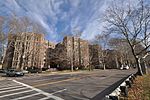Harvard rugby
1872 establishments in MassachusettsHarvard Crimson rugbyRugby clubs established in 1872Rugby union teams in Boston

The Harvard Rugby Football Club is a collegiate rugby team at Harvard College. Harvard's team is the oldest Rugby team in the United States. With around 60 members, Harvard Rugby is also one of the largest club teams at Harvard. In past years, the team traveled to Berkeley, California for the National Tournament (Top 16) after having taken the Ivy League title.
Excerpt from the Wikipedia article Harvard rugby (License: CC BY-SA 3.0, Authors, Images).Harvard rugby
Western Avenue, Boston Allston
Geographical coordinates (GPS) Address Nearby Places Show on map
Geographical coordinates (GPS)
| Latitude | Longitude |
|---|---|
| N 42.371 ° | E -71.128 ° |
Address
Harvard University
Western Avenue
02163 Boston, Allston
Massachusetts, United States
Open on Google Maps










